The Metropolitan Transportation Authority says it was one of its contractors -- not Caltrans -- that painted over a 100-foot mural commemorating the first time women were allowed to run in an Olympic marathon.
Judy Baca's 100-foot wide mural, "Hitting the Wall," had graced a wall on the 110 freeway near the 4th Street exit for the last 35 years.
In it, a female runner with her arms outstretched breaks through a finish line and takes down a brick wall with her.
The mural was commissioned for the 1984 games by the International Olympic Organizing Committee. It was protected by the 1990 Visual Artists Rights Act, which was designed to shelter recognized public art from damage, destruction or defacement, and it was copyrighted and registered with the L.A. Department of Cultural Affairs.
Baca, a professor emeritus at UCLA and the founder of the Social and Public Art Resource Center (SPARK), was shocked that her work had been completely painted over and blamed Caltrans for the whitewashing, saying she was considering legal action. Caltrans insisted it had nothing to do with it.
But on Tuesday, the Los Angeles County Metropolitan Transportation Authority (Metro) took full responsibility for the re-painting via a statement to the LAist blog, admitting one of their abatement contractors had painted over it on Feb. 26 because of what the MTA described as "extensive graffiti."
News
Top news of the day
"As part of the Freeway Beautification Program, Metro has been providing, through its contractor, supplemental landscaping, graffiti abatement and litter removal along this stretch of the 110 freeway," Metro's statement said.
"Due to the extensive graffiti coverage on the mural, our contractor did not recognize that there was a mural under this section of wall. We apologize on behalf of our contractor and will move forward to resolve this matter with SPARC."
The mural "needs to be back in the public space," Baca said. "And we need to plan a method of maintaining it and continuing to keep it clean and stop the sort of misogynist acts of young male spray can artists spraying over her legs, so that she can't run through that wall."
Baca and her team will have to begin the process of restoring the mural that sits under layers of white paint and graffiti. They can do it, she says -- they've developed a process for restoration that usually involves blasting the graffiti with water.
"It's a very thick application over and over again, with a real determination to destroy the work," she said. "So if you remove one coat, you'll have to remove the next coat and then the next coat. But we think we can do it ... we can get it back and that's our determination. We would really like to see this work come back."
Metro says it is committed to working with SPARC "to resolve this matter."
Baca says that she doesn't think many artists will volunteer to paint murals for the city during the 2028 Olympics if this is how their work will be treated.



